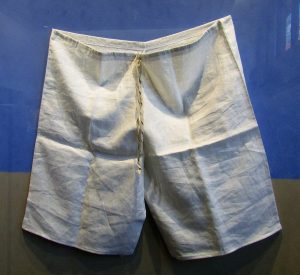Tetzaveh 2019: The Koihen’s (Priest’s) Vestments & Death
by devadmin | February 14, 2019 9:08 pm
The Koihen’s (Priest’s) Vestments & Death
Amanda Mehl’s Fashion Show
“Clothing makes the man,” so goes the old cliche. Of course we all know that clothing makes some men bankrupt as their wives shop uncontrollably. “Keep your pants on” is yet another well known cliche and is used when telling someone to have patience. It’s also used literally, if you chap, when being rebuffed from chapping, if you chap. Ober, did you know that clothing can also kill a man? Can cause death mamish? Indeed it can and especially so if one is a kohain (priest). And we know this how and from where? Let’s find out as we review parshas Tetzaveh for a 9th time. In previous editions, we covered the subject of Moishe not being mentioned even once by name -an anomaly that occurs only in this parsha and no other until the end of the heylige Toirah. As well, we reviewed various other subjects including the RBSO’s designer, custom made clothing for the kohanim (Priests). Posts going back to 2010 can be seen online at www.oisvorfer.com. They are mamish givaldig. Ober we never discussed the perils of being a kohain. Let’s do just that.
With the design of the Mishkan all laid out -last week’s parsha- and with its architectural plans already drawn, the Yiddin began planning the Mishkan project in earnest. In Parshas Vayakhale (coming up in two weeks), we will learn how the Yiddin magically came through with enough -more than enough- gold silver, copper, and other items needed for the project. We will also learn how they, -in treasure hunt fashion- were able to secure and locate many of the other items the RBSO had on His materials list. Spoiler alert: it appears that a number of the items appeared magically. Let’s recall that the generation of Yiddin traversing the Midbar was seemingly selected by the RBSO to be eye-witnesses to a great number of the RBSO’s open and overwhelming miracles. From the ten plagues He inflicted upon the Mitzrim, to the splitting of sea, the drowning of the pursuing Egyptians, bitter waters turning instantly sweet, Revelation and much more, they had seen it all. And so they would continue to see, throughout their entire 40 year journey. Munn daily, some encrusted with diamonds and the list goes on.
Ober this week, it’s fashion week, efsher the first ever in recorded history. Just last week, Amanda Mehl put on a fashion show; we will get to her soon. The RBSO will dedicate 43 pisukim (verses) in this week’s parsha to a brand new clothing line, one He himself designed. That’s 43 out of a total of 101. Was the RBSO a clothing designer and manufacturer? In fact this is the second time in Toirah history where the RBSO Himself was involved in dressing man. Truth be told, the first time, He dressed man and woman too. Efsher you recall, and you should, that following the forbidden fruit caper during which the snake seduced Chava into eating from the forbidden fruit, our Sages teach us that their eyes were suddenly opened wide and they recognized for the first time that they were naked. What did the RBSO do? He fashioned clothing for them. Says the heylige Toirah (Bereishis 3:7), azoy:
| 7. And the eyes of both of them were opened, and they knew that they were naked, and they sewed fig leaves and made themselves girdles. | זוַתִּפָּקַ֨חְנָה֙ עֵינֵ֣י שְׁנֵיהֶ֔ם וַיֵּ֣דְע֔וּ כִּ֥י עֵֽירֻמִּ֖ם הֵ֑ם וַיִּתְפְּרוּ֙ עֲלֵ֣ה תְאֵנָ֔ה וַיַּֽעֲשׂ֥וּ לָהֶ֖ם חֲגֹרֹֽת: |
Seemingly, the snake discovered their nakedness first, and taka -according to medrish- he was therefore attracted to Chava. At least one medrish records that the snake seduced Chava in more ways than one, if you chap. While she was enjoying forbidden fruit, so was he. Shoin: all that for another parsha though it is avada always good -refreshing too- to chazir the heylige Toirah, even out of order. In any event, the heylige Toirah tells us that the RBSO Himself fashioned clothing for Odom and Chava. They were the first to wear leather. Tarzan came along much later. Ober, let’s get back to our Kohanim and the RBSO’s desire for them to be well dressed.
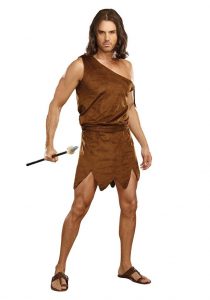 Back to our parsha where the heylige Toirah tells us that the RBSO instructed Moishe to design a line of clothing for them, the kohanim, for their honor and splendor. The kohanim were not to be dressed in schmattis, overalls, and or jeans; theirs was a collection created and designed by the RBSO Himself. Avada you all recall that regular kohanim had an ensemble consisting of four garments while the kohain godol’s (High Priest’s) consisted of eight different items. Our parsha describes each and every item.
Back to our parsha where the heylige Toirah tells us that the RBSO instructed Moishe to design a line of clothing for them, the kohanim, for their honor and splendor. The kohanim were not to be dressed in schmattis, overalls, and or jeans; theirs was a collection created and designed by the RBSO Himself. Avada you all recall that regular kohanim had an ensemble consisting of four garments while the kohain godol’s (High Priest’s) consisted of eight different items. Our parsha describes each and every item.
Now, lommer lernen (let’s learn) a few, ober not too many (avada the Oisvorfer chaps that many of his readers have trouble focusing on more than a few) very interesting pisukim (verses), and then see what Rashi, the Ramban, and a few others, including the Ohr Hachaim, had to say about what Rashi thought.
Ober before we do all that, let’s ponder over this thought: Why do you think the RBSO dedicated four entire parshas to the Mishkan project which included the clothing line, with such precision? He could easily have told Moishe to make sure the kohanim are properly dressed -maybe even formally. Or, He could have instructed Moishe to design a line of beautiful clothing for the kohanim. He could have told Moshe to build Him a Sanctuary and that He would then come down and reside there -meaning His essence of course. Instead, the most colorful details provided in the entire heylige Toirah, are dedicated to the Mishkan, and to clothing the kohanim were to don during their service -avoido- in the Temple?! Over four parshas worth! In fact, the RBSO’s instructions were so clear, few exegetes argue over them. Moreover, in recent years, as 3-D imaging has progressed, several books have been published with the most colorful and amazing details showing every facet of the Mishkan and its accoutrements. Similarly for the priestly vestments. Those who can be seen and heard arguing, cannot properly decipher the images. Yet, the building of the Mishkan and the design and manufacture of the Kohanim’s clothing line, represent but a few positive mitzvis in the entire heylige Toirah. Same say the entire Mishkan project was but one big mitzvah. Ober where is our guidebook to the other 600 plus mitzvis? What about shabbis observance? Couldn’t the RBSO at least give us details on what specific milochos are forbidden? Couldn’t He be specific? When it comes to proper shabbis observance, and the performance of other mitzvis, we need to consult and depend on Toirah She-ba’al Peh (the Oral Tradition consisting of the Mishneh and the heylige Gemora), and then a few hundred other seforim, before consulting with our local rabbis to get clarity on how each of His commandments are to be performed!? And with all that help, we still argue and fight over each mitzvah’s proper observance? Why taka did the RBSO do this?
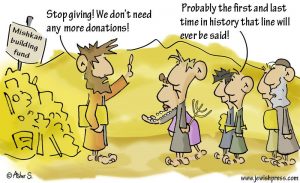 The three word answer is: we don’t know! The RBSO did not share His thought processes with us. Ober the heylige Oisvorfer has been ruminating over this question for a number of years and proffers his own thought which goes as follows. Efsher the RBSO did not want the Yiddin to be busy with the various labors -39 of them- required of the entire Mishkan Project. As an aside, these 39 forms of labor make up the foundation of what is forbidden on the heylige shabbis. What then did He want His Yiddin to do? To sit and learn His heylige Toirah. To learn it, to ask questions, to write seforim (holy explanatory books), and of course, to argue over it. We do that part quite well. Therefore, when it came to the Mishkan Project which included the Kohanim’s wardrobes, He gave us every last detail. All the Yiddin needed was one good man by the name of Betzalale whom the RBSO imbued with all the sense he needed to get the job done. Avada Betzalale had at least one senior assistant and a number of talented people to help out. The RBSO did not want too many Yiddin doing manual labor. Ober when it came time to chap what He wanted from us regarding the keeping of shabbis and the proper observance of hundreds of other commandments, kimat all other mitzvis, He gave us only outlines. By way of example only, He told us to keep the shabbis but left out the details. The Toirah came without a user friendly instruction manual. We were left to toil away and spend time trying to understand the folios of the heylige Mishneh, Gemora and myriad other seforim which further illuminate His Toirah. Es ken taka zyn pshat (it could be real pshat, ver veyst). Ober did His plan work out? For some, a smallish number, yes. For the great majority of Yiddin, they prefer many other professions including hocking. They prefer anything else but toiling over the Gemora; they want the bottom line instructions, and zicher, any loopholes around them.
The three word answer is: we don’t know! The RBSO did not share His thought processes with us. Ober the heylige Oisvorfer has been ruminating over this question for a number of years and proffers his own thought which goes as follows. Efsher the RBSO did not want the Yiddin to be busy with the various labors -39 of them- required of the entire Mishkan Project. As an aside, these 39 forms of labor make up the foundation of what is forbidden on the heylige shabbis. What then did He want His Yiddin to do? To sit and learn His heylige Toirah. To learn it, to ask questions, to write seforim (holy explanatory books), and of course, to argue over it. We do that part quite well. Therefore, when it came to the Mishkan Project which included the Kohanim’s wardrobes, He gave us every last detail. All the Yiddin needed was one good man by the name of Betzalale whom the RBSO imbued with all the sense he needed to get the job done. Avada Betzalale had at least one senior assistant and a number of talented people to help out. The RBSO did not want too many Yiddin doing manual labor. Ober when it came time to chap what He wanted from us regarding the keeping of shabbis and the proper observance of hundreds of other commandments, kimat all other mitzvis, He gave us only outlines. By way of example only, He told us to keep the shabbis but left out the details. The Toirah came without a user friendly instruction manual. We were left to toil away and spend time trying to understand the folios of the heylige Mishneh, Gemora and myriad other seforim which further illuminate His Toirah. Es ken taka zyn pshat (it could be real pshat, ver veyst). Ober did His plan work out? For some, a smallish number, yes. For the great majority of Yiddin, they prefer many other professions including hocking. They prefer anything else but toiling over the Gemora; they want the bottom line instructions, and zicher, any loopholes around them.
Shoin, let’s get back to our parsha. While describing the individual items of clothing the regular kohanim and high priest must don during the avoido (service), we come across these fascinating pisukim. One comes after the third article of clothing is described, and the other is found after the last. Says the heylige Toirah (Shmois 28: 31-35) azoy:
| 31. And you shall make the robe of the ephod completely of blue wool. | לאוְעָשִׂ֛יתָ אֶת־מְעִ֥יל הָֽאֵפ֖וֹד כְּלִ֥יל תְּכֵֽלֶת: | |
| 32. Its opening at the top shall be turned inward; its opening shall have a border around it, the work of a weaver. It shall have [an opening] like the opening of a coat of armor; it shall not be torn. | לבוְהָיָ֥ה פִֽי־רֹאשׁ֖וֹ בְּתוֹכ֑וֹ שָׂפָ֡ה יִֽהְיֶה֩ לְפִ֨יו סָבִ֜יב מַֽעֲשֵׂ֣ה אֹרֵ֗ג כְּפִ֥י תַחְרָ֛א יִֽהְיֶה־לּ֖וֹ לֹ֥א יִקָּרֵֽעַ: | |
| 33. And on its bottom hem you shall make pomegranates of blue, purple, and crimson wool, on its bottom hem all around, and golden bells in their midst all around. | לגוְעָשִׂ֣יתָ עַל־שׁוּלָ֗יו רִמֹּנֵי֙ תְּכֵ֤לֶת וְאַרְגָּמָן֙ וְתוֹלַ֣עַת שָׁנִ֔י עַל־שׁוּלָ֖יו סָבִ֑יב וּפַֽעֲמֹנֵ֥י זָהָ֛ב בְּתוֹכָ֖ם סָבִֽיב: | |
| 34. A golden bell and a pomegranate, a golden bell and a pomegranate, on the bottom hem of the robe, all around. | לדפַּֽעֲמֹ֤ן זָהָב֙ וְרִמּ֔וֹן פַּֽעֲמֹ֥ן זָהָ֖ב וְרִמּ֑וֹן עַל־שׁוּלֵ֥י הַמְּעִ֖יל סָבִֽיב: | |
| 35. It shall be on Aharon when he performs the service, and its sound shall be heard when he enters the Holy before the Lord and when he leaves, so that he will not die. | להוְהָיָ֥ה עַל־אַֽהֲרֹ֖ן לְשָׁרֵ֑ת וְנִשְׁמַ֣ע ק֠וֹל֠וֹ בְּבֹא֨וֹ אֶל־הַקֹּ֜דֶשׁ לִפְנֵ֧י יְהֹוָ֛ה וּבְצֵאת֖וֹ וְלֹ֥א יָמֽוּת: |
Let’s also learn these two pisukim. Says the heylige Toirah (Shemois 28: 42-43), azoy:
| 42. And make for them linen pants to cover the flesh of [their] nakedness; they shall reach from the waist down to the thighs.
|
מבוַֽעֲשֵׂ֤ה לָהֶם֙ מִכְנְסֵי־בָ֔ד לְכַסּ֖וֹת בְּשַׂ֣ר עֶרְוָ֑ה מִמָּתְנַ֥יִם וְעַד־יְרֵכַ֖יִם יִֽהְיֽוּ: | |
| 43. They shall be worn by Aharon and by his sons when they enter the Tent of Meeting or when they approach the altar to serve in the Holy, so they will not bear iniquity and die. It shall be a perpetual statute for him and for his descendants after him. | מגוְהָיוּ֩ עַל־אַֽהֲרֹ֨ן וְעַל־בָּנָ֜יו בְּבֹאָ֣ם | אֶל־אֹ֣הֶל מוֹעֵ֗ד א֣וֹ בְגִשְׁתָּ֤ם אֶל־הַמִּזְבֵּ֨חַ֙ לְשָׁרֵ֣ת בַּקֹּ֔דֶשׁ וְלֹֽא־יִשְׂא֥וּ עָוֹ֖ן וָמֵ֑תוּ חֻקַּ֥ת עוֹלָ֛ם ל֖וֹ וּלְזַרְע֥וֹ אַֽחֲרָֽיו: |
In verses 35, the RBSO tells Moishe that the kohanim must wear the specified clothing so that “they will not die.” And in posik 43, it states that the kohanim “should not bear a sin and die.” What’s pshat? Die for performing the avoido (Temple Service)? What was so significant about the robe described in posik 35 and the linen pants to cover their nakedness (posik 42), that would cause them to die were they to go without? Is going commando deserving of death? What’s taka pshat?
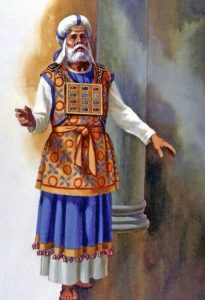 Says Rashi who seems to know everything, azoy: from the wording of the verse 35 above (“so they will not die”), we are to infer that if they do not wear the clothing -in this case, specifically the robe described above (pisukim 31-35)- they will die. Fartig, over and out! Moreover, if the kohain is missing any of the vestment articles during his avoido (service), he is deserving of death as he has committed a capital offense. OMG! Rashi will repeat this view on posik 42: should a kohain perform the service without being fully dressed in the outfits described in our parsha, he deserves death. OMG!
Says Rashi who seems to know everything, azoy: from the wording of the verse 35 above (“so they will not die”), we are to infer that if they do not wear the clothing -in this case, specifically the robe described above (pisukim 31-35)- they will die. Fartig, over and out! Moreover, if the kohain is missing any of the vestment articles during his avoido (service), he is deserving of death as he has committed a capital offense. OMG! Rashi will repeat this view on posik 42: should a kohain perform the service without being fully dressed in the outfits described in our parsha, he deserves death. OMG!
Ober says the RambaN: it’s not so! Death is only deserved should the kohain be found performing the service without his robe. Vus epes the robe? Does the robe have any special kidusha? Was it stolen from Grossinger’s or the Bellagio? Any other fine hotel? Ok, RambaN does not ask those last two questions but does state that death only comes -for now- to any kohain who performs sans robe. Why the robe? Listen to this gishmake pshat. Nu, above in pisukim 31-35, we learned that the robe came with bells attached to its bottom. And when the kohain walked, the bells would avada ring or make some other clanging type noise. Seemingly, the noise emanating from the bells attached to the robe, acted as an ‘entry request.’ In other words: the kohain godol could not just enter the Sanctuary without first knocking and announcing himself. The bells rang and metaphorically announced to the RBSO’s Essence, that the kohain was entering. Entering without such ringing was considered trespassing and could result in death the Kohain Godol (high Priest).

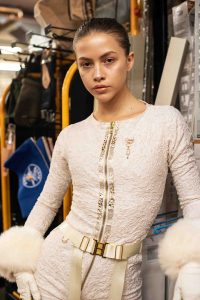 As an aside, just last week, Ch. 2 ran a shtikel piece, a review of a runway fashion show put on by Amanda Mehl (extremely talented daughter of our friends Beverly and Leon Mehl). And? Kimat every piece of clothing featured different pieces of hardware. You can see it by clicking here. We have to assume that Amanda drew some inspiration from her years in yeshiva where she efsher learned these very parshas which feature hardware and clothing. As it has done for years, the heylige Toirah keeps on inspiring entrepreneurship.
As an aside, just last week, Ch. 2 ran a shtikel piece, a review of a runway fashion show put on by Amanda Mehl (extremely talented daughter of our friends Beverly and Leon Mehl). And? Kimat every piece of clothing featured different pieces of hardware. You can see it by clicking here. We have to assume that Amanda drew some inspiration from her years in yeshiva where she efsher learned these very parshas which feature hardware and clothing. As it has done for years, the heylige Toirah keeps on inspiring entrepreneurship.
Ober what about the second warning about death, the one we read above in posik 42? Why is this repeated? Shoin: this warning is specifically given after the instructions are given for Moishe to fashion pants to cover the nakedness of the kohanim is given. In other words: any kohain found performing the avoido without pants -in this case, pants meaning undergarments to cover their nakedness: think underwear or breeches- was also condemned to death. The bottom line: the kohanim needed to be dressed in pants and to keep them on during their service.
 Ober who put the pants onto the kohanim? Did they dress themselves? Or, was it also Moishe’s job to dress the kohanim? Let’s find out? Though you might be klerring that of course each kohain put his own underpants on, you might be thinking incorrectly, and let’s see what Rashi and others had to say. Says Rashi: Moishe needed to dress the kohain godol and the kohanim into all their vestments. He did? And he knows this how? From posik 41 which states that Moishe will dress them. Fartig! Does posik 41 really say that? Let’s see. Says the heylige Toirah (Shemois 28:41) azoy:
Ober who put the pants onto the kohanim? Did they dress themselves? Or, was it also Moishe’s job to dress the kohanim? Let’s find out? Though you might be klerring that of course each kohain put his own underpants on, you might be thinking incorrectly, and let’s see what Rashi and others had to say. Says Rashi: Moishe needed to dress the kohain godol and the kohanim into all their vestments. He did? And he knows this how? From posik 41 which states that Moishe will dress them. Fartig! Does posik 41 really say that? Let’s see. Says the heylige Toirah (Shemois 28:41) azoy:
| 41. With these you shall clothe Aharon, your brother, and his sons along with him, and you shall anoint them and invest them with full authority and sanctify them so that they may serve Me [as kohanim]. | מאוְהִלְבַּשְׁתָּ֤ אֹתָם֙ אֶת־אַֽהֲרֹ֣ן אָחִ֔יךָ וְאֶת־בָּנָ֖יו אִתּ֑וֹ וּמָֽשַׁחְתָּ֨ אֹתָ֜ם וּמִלֵּאתָ֧ אֶת־יָדָ֛ם וְקִדַּשְׁתָּ֥ אֹתָ֖ם וְכִֽהֲנוּ־לִֽי: |
Rashi therefore states that Moishe had to dress them and that includes dressing them in their undergarments. OMG! Ober says the Ohr Hachaim: it’s not so! Why not? Because the instructions in 41 were given before the instructions for the kohanim to have pants. Therefore….since pants were only introduced after the instructions, the instructions cover only those 7 other items, Moishe was exempt. What a relief. And says the Levush Ha’ohrah (interesting name, as levush does in fact mean clothing), azoy: Moishe did absolutely not have to dress them in their underpants. Why not? Because Moishe dressing them into their gotchkis would be immodest. You think?! Moreover, they could dress themselves. Shoin! Ober says the Malbim: it makes no difference that instructions for Moishe to dress the kohanim came before those to make and wear pants (breeches), ober, we need to chap that it’s plainly understood that Moishe was not going to dress them; they were perfectly capable of dressing themselves.
Nu, given the logic of the Ohr Hachaim and of the Levush, why would Rashi insist that Moishe had to dress them completely, gotchkis included? Because, as the Oisvorfer has told you many times before: Rashi was a genius and knew everything. He learned the entire Toirah and came across the following posik in the very next perek which tells us azoy. Says the heylige Toirah (Shemois 29:4), azoy:
| 4. And you shall bring Aharon and his sons near the entrance of the Tent of Meeting, and you shall bathe them in water. | דוְאֶת־אַֽהֲרֹ֤ן וְאֶת־בָּנָיו֙ תַּקְרִ֔יב אֶל־פֶּ֖תַח אֹ֣הֶל מוֹעֵ֑ד וְרָֽחַצְתָּ֥ אֹתָ֖ם בַּמָּֽיִם: |
Shoin, given that Moishe was also instructed to immerse them -the kohanim- into water, meaning that he had to dunk them into the mikveh (spiritual bath), he was already seeing all the kohanim in their birthday suits -mamish nakitaheyt (totally naked). Nu, once he saw them naked, it was no longer immodest for him to dress them into their undergarments and the rest of their outfits. Mamish gishmak.
The bottom line: Keeping one’s bottoms on -at all times- protects not only one’s lower region -front and back- but also at times, one’s marriage.
A gittin Shabbis-
The Heylige Oisvorfer Ruv
Yitz Grossman
Source URL: https://oisvorfer.com/tetzaveh-2019-the-koihens-priests-vestments-death/
